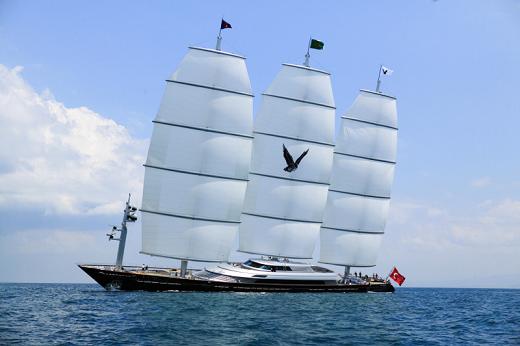 (The modern computer technology used on board this sail ship would remove the need for an all nuclear Navy if we weren't such a despicable warring species... we wouldn't be war mongers if we solved our problems man to man... rather than run away from them, rather than keep them all bottled up in stupid religions created by pent up emotions, then launching armies to conquer nations! Thanks to Tom Perkins for being another billionaire spending his money on the green revolution! RemyC.)
(The modern computer technology used on board this sail ship would remove the need for an all nuclear Navy if we weren't such a despicable warring species... we wouldn't be war mongers if we solved our problems man to man... rather than run away from them, rather than keep them all bottled up in stupid religions created by pent up emotions, then launching armies to conquer nations! Thanks to Tom Perkins for being another billionaire spending his money on the green revolution! RemyC.)Excerpt from:
Yachting Magazine, 60 Minutes and other sources.
It is a push-button boat in a very literal sense. "I can teach anyone to sail this boat in thirty minutes," Tom Perkins claims as he shows a diagram of the control panel with touch-sensitive displays of the 15 sails, each with three buttons: furl, unfurl and stop. "It takes only minutes for the boat to tack—just think, you don't have all those lines and rigging to run around."
"Computer estimates put her surfing at up to 30 knots off the wind and reaching 15 to 18 knots upwind, in 25 knots of true—with an apparent wind angle of 25 to 28 degrees."
Perkins designed the software himself for the computers that make sailing on the Falcon as easy as playing a computer game. A knob turns the masts, so that the wind blows into the sails at the perfect angle. To unfurl the boat's 15 sails, all 26,000 square feet of them, a job that would take about 80 deckhands an hour on a traditional sailboat, on the Falcon all it takes is five minutes, at the touch of a screen.
The DynaRig concept was developed in Germany in the 1960s, as a propulsion alternative for commercial ships in the face of a looming energy crisis. When the crisis actually materialized in the early 1970s, further refinement and some testing followed, but no DynaShips were built and the idea eventually went into the archives.
Gerard Dijkstra brought the DynaRig concept out again as one of several alternative sail plans for Perkins' consideration. Extensive experimentation and testing followed, with towing models, wind tunnel tests, larger self-propelled models and full-scale sail and rigging tests.
At a cool $100 million US the state of the art Maltese Falcon, designed by Perini Navi is the biggest privately owned sail boat ever built.


No comments:
Post a Comment